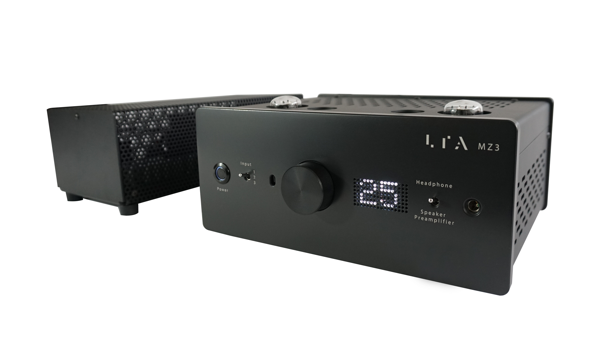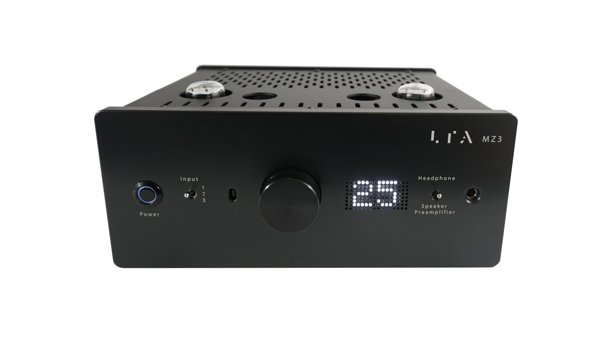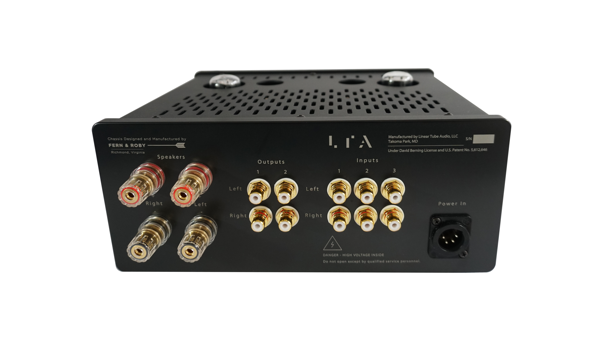
I recently reviewed the Linear Tube Audio MicroZOTL MZ3 as a one-watt integrated amp. In that review, I covered the history, description and design of the MZ3. This is a review of the MicroZOTL MZ3 as a stand-alone preamp or, more accurately, as an active-vacuum tube line stage.
You’ll find the MZ3 has a lot of the innovations from the well-received LTA MicroZOTL Preamplifier , a full-function reference preamp. For one, it has the same remote-controlled stepped attenuator volume control that has 99 steps for each channel. The stepped attenuator is constructed of 1,025 steps of 50 ohms, with 100 positions selected to provide very fine resolution at the lowest volumes and a logarithmic control for higher volumes. It uses low noise, precision 1% Vishay Dale resistors and hermetically sealed silver contact
The MZ3 also has a feature that I consider a must on a preamp, a balance control. It is achieved here by creating a numerical offset, which is applied to the volume steps between the channels; the maximum balance differential is 16 steps. This offset is stored in memory so that the amplifier can automatically apply it when it is powered on next.
Other improvements in the MZ3 from their reference preamp include ceramic circuit boards and input wiring that significantly shortens the signal path and ceramic circuit boards. There are also several integral component upgrades in the audio circuit. So, in many ways, the MZ3 is a smaller version of the reference preamp with three inputs, two outputs, no tape loop and
My History with Preamps
Before I go any further with this review, I’ll share a little of my preamp history to provide context for my opinion on the sound of the MZ3. I have owned plenty of fine preamps from Audio Note, Audio Research, Emia, QUAD of England and Shindo. I have reviewed even more.
My reference preamp for several years was a Shindo’s Giscours. Then at the Rocky Mountain Audio Fest in 2013, I heard Jeffery Jackson’s stunning room that was put together by Win Tinnon of Win Tinnon Audio, Dave Slagle of Emia and Jackson. The room featured Win Tinnon’s idler drive turntable, electronics from Emia, including Jackson’s 2-watt Emia Permalloy type 50 tube amplifiers with Slagle’s Emia Remote Autoformer with silver-wound audioformers, an Emia phono stage and an Emia SUT wound with silver wire. Rounding out this incredible-sounding system were RCA LC-1A LS-11 vintage speakers from the 1950’s that were Win’s personal reference speakers.
All I can say is that the entire system rocked my world! I had to review some of the Emia products. So, I got the Emia Remote Silver Autoformer in 2013 but had to wait until 2018 for the Emia Strain Gauge Cartridge with the Equalizer Phono Preamp. Both products are incredible artisan works. I purchased and have used Emia Remote Silver Autoformer as my line stage since 2013.
Moving on a bit, I found out last year that the MicroZOTL MZ2 could function as a great preamp. When the MZ3 came out, I expected it to be a more finished-looking product with more functions than the MZ2, however, I never expected the sonic improvements that I heard.
The MZ3 let me hear the different tones and qualities of each amp, phono cartridge and cable I had in for review. I’m not saying something stupid like the MZ3 has no sound of its own. I believe any preamp, amp or any other audio component adds to the sound.

Components Used in this Review
For this review, I used the MZ3 with LTA’s own ZOTL10 Mk.II amplifier, my Pass Labs XA30.8, Parasound’s new ZM2350 (review coming soon), and the First Watt SIT-3. I’m so sad that the LTA ZOTL Ultralinear I reviewed wasn’t still at my house, but someone local asked Mark if they could hear it, and I haven’t gotten it back, so I guess that guy liked it as much as I did. I bet the MZ3 with the Ultralinear would really be something else. However, the combination of the MZ3 with the LTA ZOTL10 Mk.II amplifier was pretty magical, and I expect this combo sounds a lot like their new integrated amp.
I also used the preamp with three sources; my DS Audio Master1 Optical Cartridge and Phono Preamp, the Innuos Mini II Music Server with both my BorderPatrol SE DAC and the new Digital Amplifier Company’s DAC DAC 2 HS. I was surprised and pleased to finally find a preamp that got the best out of both my analog and digital sources. All of these sources were more organic, had better tonality and most of all sounded more like live music than they did with the MZ2s or the Emia Remote Autoformer.
Listening Notes
As good as the MZ3 sounded as a one-watt amp with my Teresonic Ingenium 103 dB efficient speakers, most people will not be able to use it that way. No worries,
The SIT is a custom part that Pass commissioned from the now-defunct SemiSouth Company, and he says it has the character of a tube triode. The SIT-3 is the third and last of Nelson’s First Watt SIT amplifier designs. It differs from the SIT-1 and SIT-2 in that the SIT-3 operates in common drain mode rather than common source like the SIT-1. It is an 18-watt stereo, single-ended, Class A amplifier with more power, lower distortion, lower noise and better damping than its predecessors.
Nelson says, “The SIT-3 has more power, more damping factor and less distortion than the previous SIT designs. It retains their desired second harmonic character with even fewer higher order harmonic components … The SIT-3 has an organic quality that breathes more depth and life into the music … This is one of those all-night, year-after-year pieces.” So, this incredible sounding combo is from two amplifier geniuses, Nelson Pass who designs transistor amps without most of the weaknesses of the type and David Berning whose unique tube amp designs exhibit very little of the weaknesses of tube amps.
Every one of David Berning’s ZOTL Class A incarnations I have heard seems to let you hear a real sense of aliveness that gives me greater emotional impact from the music. The new MZ3 really raises the bar. It breathes the breath and sound into music that I remember from the wonderful Shindo preamps and the powerful bass and extended top end of the Pass Labs Xs Preamp, and it even seems quieter than the Pass Labs Xs or any passive line stage that I have heard.

Summing Things Up
I can’t say that I’m completely shocked that the new Linear Tube Audio Mz3 is such a great preamplifier. However, even with all of the great and expensive preamps I have had in my system over the years, I was still astounded at the level of improvement the MZ3 brought.
It took Mark Schneider and David Berning three years of development to get the very best sound from the ZOTL design. I thank them for their hard work as this preamplifier allows my system to have rich organic timbres, beautiful tonal colors, and a sense of “aliveness” that is so emotionally involving. The MZ3 allowed my system to have a near perfect spatial perspective where the musicians occupied a real acoustic space and a real coherent soundstage with almost perfect scale. With the MZ3 my system had
One last thought, the MicroZOTL MZ3 sells for $3,700 while the MicroZOTL Preamplifier sells for $4,450. So, I asked Mark if there were any sonic differences between the two, and he said absolutely not. What you do get for

Great review. After reading your earlier review of the MZ3 as integrated amp, I ordered the MZ3. I am very impressed using it as a preamp with FirstWatt F7 and Pass Labs XA25. The pairing with F7 is magical and delightful. Can you share some impressions about the difference in the sound when pairing MZ3 with SIT3 vs ZOTL10 mk ii? The MZ3 is my first LTA amp and I am so tempted to order an UltraLinear but I am uncertain sincethe UL is said to be similar to the XA25. I didn’t get the SIT3 because I already have the F7. Thanks.
Thanks, Andy for reading our site and commenting on the review. Just buy the Ultralinear. It is an incredible amp! The 10 is good but not in that league.
Thanks,
jack
The MZ2 got some rave reviews as a headphone amplifier; do I remember you are going to give a review of the (apparently remarkably upgraded) MZ3 for use with headphones? With a plethora of flagship headphones now available (Focal Utopia, HiFiMan HE-1000, Audeze LCD-4, and most recently the less expensive but lauded Mr. Speakers Ether 2) many of us would be interested in how the MZ3 performs with some or all of these! Several people make really nice solid state headphone amplifiers (Jason at Head-Amp comes to mind) and of course there is Woo Audio (and several others) who offer a tube-based design for those of us with that bent. At $3700 for the MZ3 I’m curious: as a headphone amp is it a must listen (if not a must buy) for those in the market for a flagship (tube-based) amplifier? to go with flagship headphones?
Jack I wholeheartedly support Jeffrey’s thought that a follow-up segment/review of the MZ3 as an end game head amp is in order, if not dictated in a sense, as LTA lists the head amp function in the MZ3 as one of it’s “ultimate expressions” of the ZOTL tech. With the immense popularity of the headphones Jeffrey stated, as well as numerous others such as Meze Empyrean, Abyss Phi CC, ZMF Vérité, and others…. I would think a lot of other readers may be waiting for/wanting this as well (that review). May all of the sonic qualities you have expounded upon regarding the amp/ preamp functions be safely assumed to be included in the sonic presentation the head amp provides??
Thank you for your thorough and insightful reviews so far regarding the MZ3. Can we make it a trifecta?? ??